This short avant garde film provoked three very strong reactions from me: (1) No amount of adulation or awe of Jim Henson is too much; (2) I’m sorry I missed the Sixties; and (3) Frank Oznowicz?!
Author: bobg
My five-year mission
My years working on the Andrew project were golden. Part of this is due to the effect of nostalgia, of course; another part is due to the novelty of a regular paycheck; still another, the outstanding colleagues from whom I learned so much. But a big part of what I loved about that job was being able to perceive the effects of my work on my user base, for better or worse, which not all software engineers are able to do. When we rolled out a new feature that I had worked on, the campus message boards would immediately light up with excitement about it. When e-mail wasn’t working well, the frustration emanating from all corners of the university was palpable in my office. And if I was then able to fix it — especially if it involved clever detective work — that was my idea of heaven.
(On one memorable occasion, I unadvisedly rolled out a version of the mail system on my own to the whole campus late at night, thinking to fix a small bug; instead I broke mail for everyone. Frantically I tried to fix things until I realized I couldn’t without help, and that help wouldn’t arrive until early the next morning. The thought that mail wasn’t working for anyone at CMU that night tormented me so that I went to a local bar to drown my sorrows. A cute waitress there who was an acquaintance of mine listened to my story and sympathized with me. “And today that woman is my wife.”)
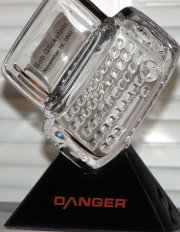
Five-year trophy
This is the fifth anniversary of my joining Danger, Inc., a cool company with cool people, products, and services. A big part of what I love about this job is that it recaptures a lot of what I loved about the old CMU job: once again I am overseeing a high-volume, advanced-technology e-mail service used by a very large number of people all the time, and once again I have the occasional pleasure of hunting down and solving serious software bugs and making life better for everyone at once.
On this particular day, though, as I recuperate from a week of pneumonia, what I’m most grateful for is Danger’s health insurance plan… and my fleecy, unreasonably comforting “Danger” hoodie, without which recovery would have been nigh impossible.
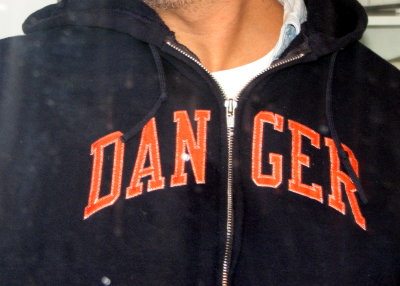
Pneumonia?!
Seriously, 2007, you are starting to piss me off.
Censure Dianne Feinstein
In the recent past she has outdone herself in coddling the Bush administration. She helped Michael Mukasey become Attorney General — the top law-enforcement officer of the nation — despite his refusal to renounce torture, an illegal practice. And she has voiced her support of “telecom immunity,” which would rescind privacy laws that telecom companies broke, for no reason other than that the burden of defending themselves in the resulting lawsuits is too onerous. (Message: break any laws you want if you can pay later to have it officially overlooked.)
These actions were taken under a serious conflict-of-interest cloud. Feinstein’s husband, Richard Blum, is a defense contractor whose company has won lucrative no-bid contracts from the Bush administration.
Every time I’ve mailed her an objection, I’ve received a prompt, polite, and discursive response telling me we’ll just have to “agree to disagree.” Enough of that.
So I’ve joined the Courage Campaign’s effort to have the California Democratic Party censure her. Please do the same.
I also plan to send her a small bottle of cheap perfume with the note, “You stink.”
The beginning of wisdom
[This post is participating in Strange Culture’s Film + Faith Blog-a-thon. Warning: spoilers follow for the book and film Contact. Update 16 Dec: this post is also participating in Joel Schlosberg’s second annual Carl Sagan Memorial Blog-a-thon.]
I read Carl Sagan‘s novel, Contact, soon after it was published in the late 1980’s, and enjoyed it greatly. It’s the story of a radio astronomer, Ellie Arroway, who is the first person on Earth to detect, verify, and begin deciphering a genuine extraterrestrial message.
A considerable part of the story is devoted to the societal implications of Arroway’s discovery, especially among various religious communities. As it’s depicted in the book, Ellie must suffer various crackpots, blowhards, and garden-variety religious leaders (well-meaning but deluded) spouting their superstitious blather in her quest to secure the resources needed to finish decoding the alien transmission and build the Great Machine.
For the transmission includes, among other things, construction plans for a tremendous and tremendously complicated machine. At its center is a capsule that seats five intrepid adventurers. No one knows what will happen when the machine is switched on. Will the capsule launch into space? Travel through time? Pop into a different dimension? Or is it a weapon that will obliterate the Earth?
The trials involved in achieving the goal of building and activating the Machine are portrayed very much as the power of pure reason overcoming the fetters of fear and ignorance. In the end, Ellie and her fellow travelers are propelled across vast distances and have a surprising encounter with a superior but benevolent race. When they return days later, they discover that no time has elapsed on Earth, leaving a diehard core of doubters free to insist that nothing at all happened, even though there is compelling evidence to support the stories told by Ellie and the others. Science is the clear winner, religion the loser, and it’s pure wish fulfillment: what atheist hasn’t dreamed of winning one of those unwinnable arguments about faith and science against a true believer?
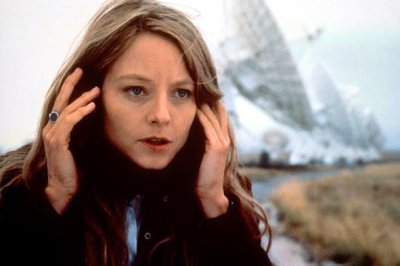
In Robert Zemeckis’ film version of Contact, things are subtly different. Ellie is as much an empiricist as in the book, but man-of-God Palmer Joss is much less easy to dismiss out of hand. His interplay with Ellie on the subject of faith leaves her uncharacteristically at a loss, unable to turn him aside by articulating the bedrock principles of skeptical inquiry.
When the time comes to try the Machine, crucially there is room in it for only one person, so that when Ellie returns from her amazing journey there is no one to corroborate her account. There is also a total absence of physical evidence to support her story. Ellie ends up passionately, desperately trying to persuade people to believe what she is certain is true but cannot prove. Palmer Joss sympathetically points out that this is precisely the situation in which persons of faith find themselves.
It’s a marvelous storytelling contrivance, and the dialogue and performances drive the point home economically and convincingly. But I left the theater conflicted. On the one hand, the film had excellent performances and astonishing visuals, it was exhilarating to see an intelligent, uncliched portrayal of science and scientists in a mainstream Hollywood movie, and it was in many respects faithful to the novel. Where changes were made, by and large they were to add some emotional depth that had been missing from Sagan’s plot- and technology-heavy writing. On the other hand, the rebalancing of science and religion changed what the story was fundamentally about! It offended me that Carl Sagan, recently deceased after a lifetime of science advocacy (today would have been his 73rd birthday, by the way), should have his fantasy about the triumph of humanism and reason watered down for a mass audience!
Over time, though, the film version grew on me and I recognized it as something greater than the source novel: an adventure in which reason triumphs and an exploration of the tangled interrelationship between belief and skepticism. Where I had been hoping to see religious moviegoers get schooled in the virtues of rational thought, instead I had received a lesson about the nuances and complexities of the human experience. The science-beats-religion version of the story had become, to me, overly simplistic. (Sorry, Carl.)
After all, even Mr. Spock admits, near the end of a long career working with humans, that “logic is the beginning of wisdom, not the end.”
It’s all about you
The NYGirlOfMyDreams story? Thanks to me, it’s all about you.
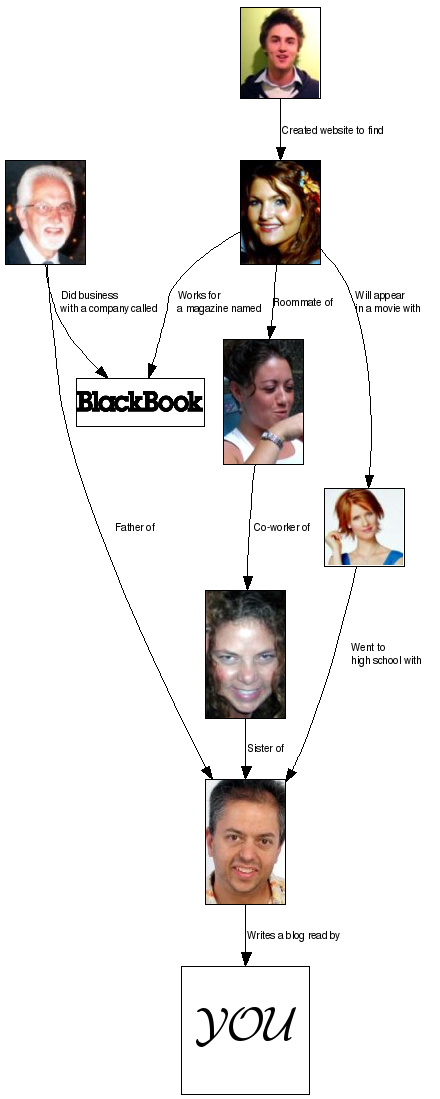
Webmaster deletes leaf node
Webmaster deletes leaf node, then performs some site maintenance.
CHUD!
[This post is participating in M.A. Peel’s Comedy Blog-a-thon.]
It may be immodest of me to identify, as my “purest comedic moment,” one that I helped to create. But when I try to think of one that I merely experienced, there are a thousand different ones vying for the top spot. On the other hand, of my own comedy there was a single moment that stands above the rest.
As I mentioned a few months ago, some friends and I won our ninth grade talent show with a comic act called “The Epiphany County Choir.” Wearing plaid flannel shirts, bad haircuts, and dumbfounded expressions, we pretended to be country bumpkins from Nebraska newly arrived in the Big Apple. We sang “When it’s hog-calling time in Nebraska” to much laughter and applause.

A short time later, through some connections of Chuck’s as I recall, we got a gig performing our Epiphany County Choir act in front of a studio audience on a local cable-access show. We arrived at the studio early on a Saturday morning excited and nervous, chatted a bit with the station manager, and then were shown onto the stage in front of our audience: a class of 2nd-graders from Harlem.
The show must go on. We gamely performed “Hog Calling Time” in character, but to say our humor was lost on them is giving too much credit to the connotative powers of the word “lost.” We left the stage and huddled in the waiting room with the station manager and the schoolteacher, who registered her displeasure at the choice of entertainment for her charges. She wanted to know if we had anything more age-appropriate to perform for her kids. 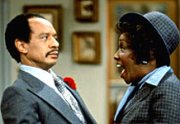 Chuck, apparently interpreting this to mean “race-appropriate,” indelicately suggested, “We do know the theme song from The Jeffersons.”
Chuck, apparently interpreting this to mean “race-appropriate,” indelicately suggested, “We do know the theme song from The Jeffersons.”
Because the world is funny, today Chuck is a professional diplomat.
Embarrassing at the time, that episode is funny in hindsight, and Chuck has gotten his share of ribbing for his gaffe, but that wasn’t my purest comedic moment. Read on.
We reprised our Epiphany County Choir act the following year to reasonable acclaim, with about twenty minutes of new material. The year after that we decided to stage our own hour-long show: “The Epiphany County Choir Home-For-Christmas Television Special” (in April).
Feeling we hadn’t sufficiently promoted the show in advance, we stood outside the entrance to our school on show day, lined up in our flannel shirts and in character, repeating the following in unison over and over and over for about forty-five minutes as students arrived for classes: “Come to the Epiphany County Choir Home-For-Christmas Television Special, 11:30 in the auditorium for free! Come to the Epiphany County Choir Home-For-Christmas Television Special, 11:30 in the auditorium for free! Come to the Epiphany County Choir Home-For-Christmas Television Special, 11:30 in the auditorium for free!” You try it, see how long you can keep it up.
The show included a performance of “Silver Bells” on a set of handbells; an Andy-Kaufman-style pantomime to a recording of “So Long, Farewell” from The Sound of Music; an a capella rendition of the theme music from The Odd Couple; an audience “sing-along” consisting of nothing but hand-clapping; and more. We were a hit; the crowd loved us.
But the coup de grace was the “Chud game.” Steve set the stage with a few minutes of (intentionally) bad stand-up about Chud, the neighboring county to Epiphany. “They call themselves Chuddites over there,” he told the audience with barely suppressed mirth, “but we just call ’em Chuds!” (Whereupon we in the Choir crack up.) There followed several supposedly disparaging Chud jokes — e.g., “How many Chuds does it take to screw in a light bulb? Fifteen!” — and then our helpers distributed Chud cards to the audience members.
The night before, we had drawn up hundreds of Chud cards by hand. These were Bingo cards, but with four columns apiece, labeled C, H, U, and D. Each card was different, just like real Bingo cards, but they were all rigged to win simultaneously when we called the four prearranged “Chud numbers.” I should mention that this was more than a year before “C.H.U.D.” stood for Cannibalistic, Humanoid Underground Dwellers.
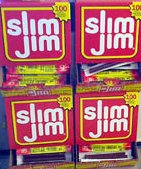 After the Chud cards were distributed, Steve announced that the winner would receive a prize. The prize was beef jerky. A few days earlier, Andrew and I had gone to a snack-food wholesaler to buy enough beef jerky for the whole audience.
After the Chud cards were distributed, Steve announced that the winner would receive a prize. The prize was beef jerky. A few days earlier, Andrew and I had gone to a snack-food wholesaler to buy enough beef jerky for the whole audience.
I cranked the handle of a genuine Bingo cage we had secured from somewhere, and I handed the chosen numbers to Steve one at a time. Although he made a big show of trying to read the numbers off the balls, of course he didn’t actually; instead he announced the numbers we had arranged the night before. “C-8!” “U-32!” “D-49!” By the third number it was obvious to the audience what we were up to and they began laughing and clamoring. Steve threw an unrehearsed curveball, announcing a number we hadn’t planned, and I was momentarily furious with him, worried that someone might prematurely win the game — but no, he succeeded in building a little suspense.
When he finally announced, “H-18!” the entire audience jumped to its feet and roared, “CHUD!” in unison. Somewhere there is video footage of me, Steve, and the others in the Choir with perfectly astonished looks on our faces as the crowd dissolved into screaming laughter. (We never could have pulled it off without cracking up ourselves if we hadn’t stayed awake the entire night before, preparing the show and rehearsing, making ourselves weary and slightly sick from too much beef jerky.) In my wildest dreams I could not have imagined causing such merriment or producing such a response. It was my purest comedic moment.
Matchmaker, part 1
 A few days ago I read an article speculating that the one-man computer-dating company, PlentyOfFish.com, may be worth a billion dollars.
A few days ago I read an article speculating that the one-man computer-dating company, PlentyOfFish.com, may be worth a billion dollars.
This inspired me to write the following rambling reminiscence of my forays into computer dating services — not as a customer, but as an operator.
It all started when I taught myself the computer language BASIC in anticipation of winning an Apple II computer in a magazine contest. To my great surprise I didn’t win (and in related news: I’m not the center of the universe) but, luckily for me and my nascent programming skills, 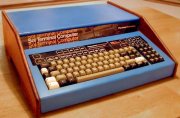 my new friend Chuck had a computer at home, which was almost unheard of in those days. (His dad was a professional programmer and weekend computer hobbyist.)
my new friend Chuck had a computer at home, which was almost unheard of in those days. (His dad was a professional programmer and weekend computer hobbyist.)
Chuck and I bonded over our shared nerdiness. How nerdy? In our seventh-grade music class, one homework assignment was to develop a board game illustrating the differences between different eras of classical music history. We undertook an electrical engineering project, drawing up circuit diagrams, buying parts at Radio Shack, and soldering them together in Chuck’s basement.  The resulting game, which we called ElectroMusiQuiz, required players to answer music-history questions on cards that could then be inserted into a slot that would cause the right answer to appear on a 7-segment LED. A right answer meant you could advance your gamepiece across the board. ElectroMusiQuiz was extremely crude, but on the day everyone brought in their board games, ours was the one everyone wanted to try!
The resulting game, which we called ElectroMusiQuiz, required players to answer music-history questions on cards that could then be inserted into a slot that would cause the right answer to appear on a 7-segment LED. A right answer meant you could advance your gamepiece across the board. ElectroMusiQuiz was extremely crude, but on the day everyone brought in their board games, ours was the one everyone wanted to try! 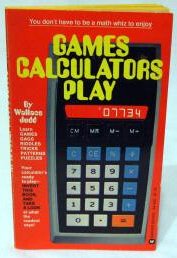 (This was before ubiquitous electronic goodies, you must understand, when upside-down illegible-word calculator games were all the rage.) It earned us a commendation from the principal’s office.
(This was before ubiquitous electronic goodies, you must understand, when upside-down illegible-word calculator games were all the rage.) It earned us a commendation from the principal’s office.
Over the next couple of years, Chuck and I spent countless afterschool hours with our heads together in front of his computer, laboriously typing in long program listings from issues of Byte and Dr. Dobbs Journal of Computer Calisthenics & Orthodontia, trying out our own creations in NorthStar BASIC and later UCSD Pascal, or just loading Adventure or Trek-80 from a 500-baud audio cassette and playing until dinnertime.
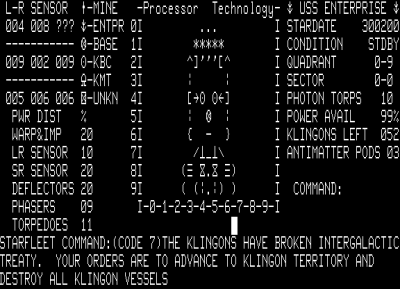
The state of the art in computer gaming circa 1980. We loved it.
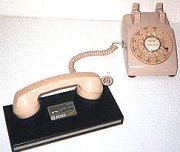 Occasionally we’d watch in awe as Chuck’s dad used a modem to connect his computer to the mainframe at his office. It was an acoustic modem, the kind Matthew Broderick uses in WarGames, where a telephone handset is jammed into a pair of rubber cups, one housing a mic for listening to the screechy data sounds from the handset, and one housing a speaker for making screechy data into the handset’s mic. Such a device was only possible, of course, at a time when telephone handsets were all a standard size and shape.
Occasionally we’d watch in awe as Chuck’s dad used a modem to connect his computer to the mainframe at his office. It was an acoustic modem, the kind Matthew Broderick uses in WarGames, where a telephone handset is jammed into a pair of rubber cups, one housing a mic for listening to the screechy data sounds from the handset, and one housing a speaker for making screechy data into the handset’s mic. Such a device was only possible, of course, at a time when telephone handsets were all a standard size and shape.
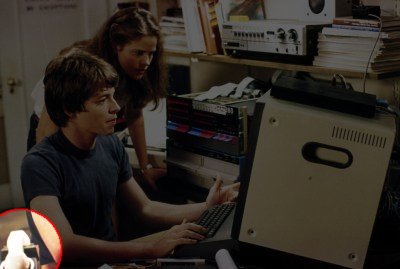
One day in eleventh grade (1982-83) we learned that our school had a computer terminal with a built-in acoustic modem — a teletype-style machine, with a roll of paper for printing the output, line by line, from whatever computer you connected it to. Around the same time we learned that it was almost time for our school’s annual Carnival, and we hatched this idea: we would operate a computer-dating booth. A few weeks before Carnival, we’d circulate personality questionnaires to all students. We’d collect them and enter the data from the completed forms into a computer-dating program that we would write for Chuck’s computer. On the day of Carnival, we would set up the terminal in an unused classroom, connect it by phone to Chuck’s computer at home, and direct it to output a list of the five best matches (as determined by our program) for anyone who showed up and handed over a couple of Carnival tickets.
To my modern self, the ambitiousness of that plan is breathtaking. As a harried parent who works full time (married to another harried parent also working full time), for whom merely writing in my blog requires stealing moments here and there for days on end, the level of effort that plan implies makes me cringe. But we were young and our responsibilities were few. Somehow in the space of a few short weeks we:
- Got approval from some teachers to set up this “booth” and use the teletype;
- Wrote a personality questionnaire (filled with random questions pulled out of thin air);
- Sweet-talked the Social Studies department’s office into letting us have some of their mimeograph stencils for typing up the questionnaire — most of which we ruined with imperfect typing (including one memorable copy in which the text was perfect but which was then cut in half by a line of underscores I added at the bottom for the submitter’s name!);
- Got high on mimeograph fumes and then distributed the blank questionnaires to over a thousand schoolmates;
- Wrote, debugged, and tested the software for enabling data entry, saving and loading the data to and from a disk file, and executing the matchmaking computation;
- Roped Chuck’s dad into staying home on the day of Carnival in order to assist with establishing the modem connection and any technical issues that might come up;
- Collected completed questionnaires from hundreds of students;
- Made a crooked deal with one classmate to ensure a certain student appeared in her list of matches (and vice versa) in exchange for an invitation to her upcoming sweet sixteen party.
On the night before Carnival there were still hundreds of questionnaires to enter into Chuck’s computer. There were four of us working at it: me and Chuck; my girlfriend Erica, and her friend Mari. It was slow, gruelling work that we did in two-person teams, one reading data aloud from the forms, the other typing it in, occasionally saying, “Wait, wait…” After a while, the reader’s voice would grow hoarse and the typist’s hands would cramp up, and they’d switch roles, or swap in the other two-person team.
As the hours dragged on long past midnight and our weariness came close to despair, there was one consolation for me at least: while Chuck and Mari worked and it was Erica’s turn and mine to rest, we made out almost continuously, like the indecent sixteen-year-olds we were.
Finally, some time past 3am, the last questionnaire was entered. We amused ourselves for a short time by querying the matching engine a few times to see which of our classmates matched up with whom (untroubled by the ethical or privacy compunctions — see “crooked deal” above — that would constrain our later adult selves), then called it a night.
Not enough sleep later, we went to school and set up the computer-dating room. We pushed all the chairs and desks in a classroom toward the back wall and wheeled in the teletype, then brought in a telephone with a cord long enough to reach the nearest extension jack across the hallway in the Foreign Languages office. Next we called Chuck’s dad at home and instructed him to begin the computer connection and then jammed the handset into the terminal’s modem. After fiddling around with various settings (learning on the fly about the difference between “full duplex” and “half duplex”), we were up and running! To our considerable surprise.
Almost as soon as we posted our sign on the classroom door, a line formed out the room and down the hallway. We began collecting Carnival tickets, running the matching engine, and delivering the results — a list of fellow students’ names — in the form of printouts torn off the teletype. But the matching engine was slow, taking up to five minutes to produce one set of results, and the line of “customers” just grew and grew. Now and then someone tripped over the phone line and disconnected us, and we’d have to call Chuck’s dad again and arrange a mutual jamming of telephone receivers into modems.
As the delays mounted, the crowd’s mood started to sour, and they began clamoring for faster service. To add to our troubles, the teletype began printing strings of random characters at unpredictable intervals, occasionally dropping the connection! Before long we figured out that this was caused by the noise of the crowd getting into the acoustic modem and being mistaken for data! So we moved the queue into the hallway, closed the door, and admitted just one person at a time.
A few hours later, we closed the computer-dating booth. We had collected a small mountain of Carnival tickets and congratulated ourselves on a job well done.
(To be continued…)
Starting again again again
I’m still not managing to melt the pounds away, so I’m resetting the start date of my weight-loss effort to today, but keeping the end date the same (July 1st). That gives me 212 days to lose 29 pounds; less than a pound a week. That should be doable, right?
I plan to reduce my portion sizes, pay closer attention to the nutrition-per-calorie content of what I eat, get on my bike more often, and use Kinetic as my simulated personal trainer.
Or maybe I’ll just hibernate for the winter and metabolize my fat reserves.